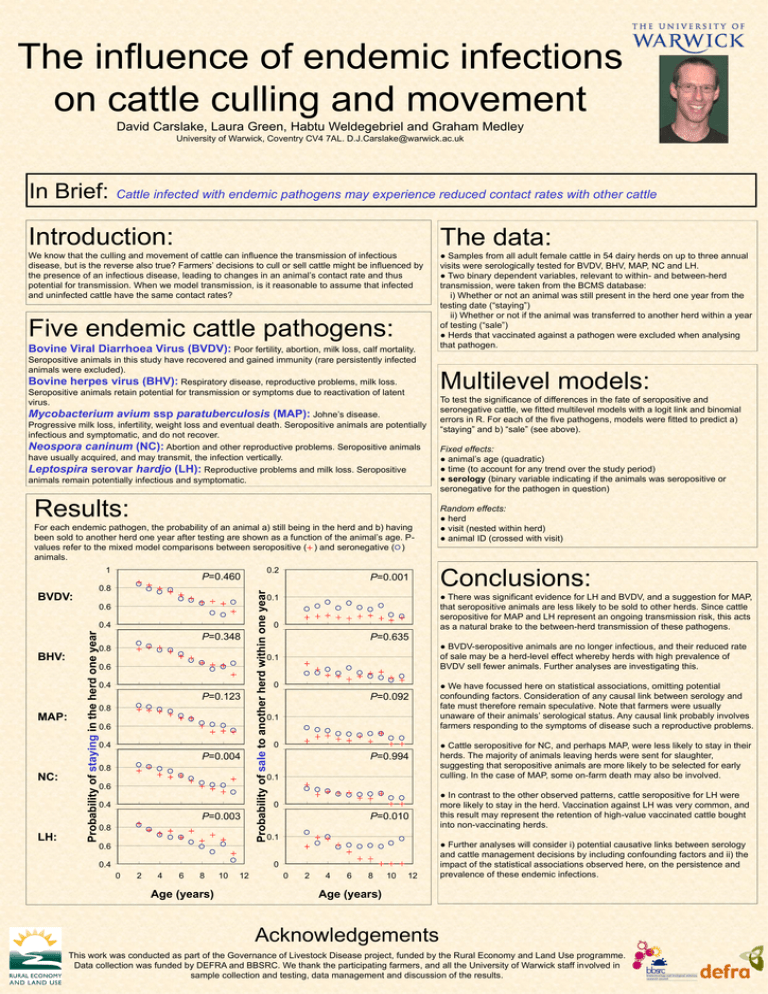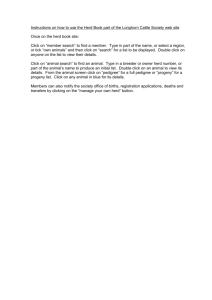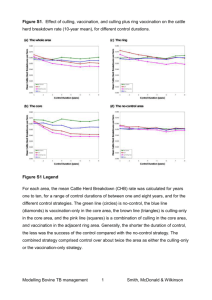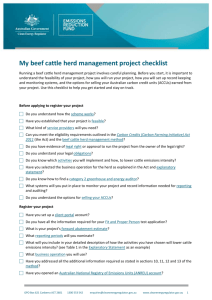The influence of endemic infections on cattle culling and movement Introduction: The data:
advertisement

The influence of endemic infections on cattle culling and movement David Carslake, Laura Green, Habtu Weldegebriel and Graham Medley University of Warwick, Coventry CV4 7AL. D.J.Carslake@warwick.ac.uk In Brief: Cattle infected with endemic pathogens may experience reduced contact rates with other cattle Introduction: The data: We know that the culling and movement of cattle can influence the transmission of infectious disease, but is the reverse also true? Farmers’ decisions to cull or sell cattle might be influenced by the presence of an infectious disease, leading to changes in an animal’s contact rate and thus potential for transmission. When we model transmission, is it reasonable to assume that infected and uninfected cattle have the same contact rates? ● Samples from all adult female cattle in 54 dairy herds on up to three annual visits were serologically tested for BVDV, BHV, MAP, NC and LH. ● Two binary dependent variables, relevant to within- and between-herd transmission, were taken from the BCMS database: i) Whether or not an animal was still present in the herd one year from the testing date (“staying”) ii) Whether or not if the animal was transferred to another herd within a year of testing (“sale”) ● Herds that vaccinated against a pathogen were excluded when analysing that pathogen. Five endemic cattle pathogens: Bovine Viral Diarrhoea Virus (BVDV): Poor fertility, abortion, milk loss, calf mortality. Seropositive animals in this study have recovered and gained immunity (rare persistently infected animals were excluded). Bovine herpes virus (BHV): Respiratory disease, reproductive problems, milk loss. Seropositive animals retain potential for transmission or symptoms due to reactivation of latent virus. Mycobacterium avium ssp paratuberculosis (MAP): Johne’s disease. Progressive milk loss, infertility, weight loss and eventual death. Seropositive animals are potentially infectious and symptomatic, and do not recover. Neospora caninum (NC): Abortion and other reproductive problems. Seropositive animals have usually acquired, and may transmit, the infection vertically. Leptospira serovar hardjo (LH): Reproductive problems and milk loss. Seropositive animals remain potentially infectious and symptomatic. Results: For each endemic pathogen, the probability of an animal a) still being in the herd and b) having been sold to another herd one year after testing are shown as a function of the animal’s age. Pvalues refer to the mixed model comparisons between seropositive ( ) and seronegative ( ) animals. P=0.460 0.8 BVDV: NC: LH: Probability of staying in the herd one year 0.4 MAP: P=0.001 P=0.348 0.8 0 P=0.635 0.1 0.6 0.4 P=0.123 0.8 0 P=0.092 0.1 0.6 0.4 P=0.004 0.8 0 P=0.994 0.1 0.6 0.4 P=0.003 0.8 0 P=0.010 0.1 0.6 0 0.4 0 2 4 6 8 Age (years) 10 12 To test the significance of differences in the fate of seropositive and seronegative cattle, we fitted multilevel models with a logit link and binomial errors in R. For each of the five pathogens, models were fitted to predict a) “staying” and b) “sale” (see above). Fixed effects: ● animal’s age (quadratic) ● time (to account for any trend over the study period) ● serology (binary variable indicating if the animals was seropositive or seronegative for the pathogen in question) Random effects: ● herd ● visit (nested within herd) ● animal ID (crossed with visit) Conclusions: ● There was significant evidence for LH and BVDV, and a suggestion for MAP, that seropositive animals are less likely to be sold to other herds. Since cattle seropositive for MAP and LH represent an ongoing transmission risk, this acts as a natural brake to the between-herd transmission of these pathogens. 0.1 0.6 BHV: 0.2 Probability of sale to another herd within one year 1 Multilevel models: 0 2 4 6 8 10 12 ● BVDV-seropositive animals are no longer infectious, and their reduced rate of sale may be a herd-level effect whereby herds with high prevalence of BVDV sell fewer animals. Further analyses are investigating this. ● We have focussed here on statistical associations, omitting potential confounding factors. Consideration of any causal link between serology and fate must therefore remain speculative. Note that farmers were usually unaware of their animals’ serological status. Any causal link probably involves farmers responding to the symptoms of disease such a reproductive problems. ● Cattle seropositive for NC, and perhaps MAP, were less likely to stay in their herds. The majority of animals leaving herds were sent for slaughter, suggesting that seropositive animals are more likely to be selected for early culling. In the case of MAP, some on-farm death may also be involved. ● In contrast to the other observed patterns, cattle seropositive for LH were more likely to stay in the herd. Vaccination against LH was very common, and this result may represent the retention of high-value vaccinated cattle bought into non-vaccinating herds. ● Further analyses will consider i) potential causative links between serology and cattle management decisions by including confounding factors and ii) the impact of the statistical associations observed here, on the persistence and prevalence of these endemic infections. Age (years) Acknowledgements This work was conducted as part of the Governance of Livestock Disease project, funded by the Rural Economy and Land Use programme. Data collection was funded by DEFRA and BBSRC. We thank the participating farmers, and all the University of Warwick staff involved in sample collection and testing, data management and discussion of the results.






